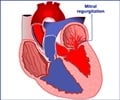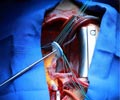Mitral Valve Stenosis - Congenital
Congenital: Mitral valve stenosis is sometimes seen in babies born with deformities in the mitral valve structure or subvalvular apparatus. Some of the pathological conditions are
- Double orifice mitral valve- the mitral valve opening is divided into two by an abnormal tissue; or there is an extra opening in the mitral valve leaflets; or two mitral valves with its own annulus, leaflets, chordae tendinae and papillary muscles are present. Among these three, the accessory hole type is the most common and the duplicate valve is the least common type. 50% of the patients with this defect have normal mitral valve function.
- Parachute mitral valve – The chordae are thick and short and regardless to its leaflets they are attached to one or two papillary muscles only. The valve resembles a parachute’s canopy.
- Fusion of the commissures- when there is a fusion of the mitral valve commissures, it leads to an obstruction in the blood flow to the left ventricle. Further calcification can result in increased resistance to the flow.
These anomalies often are associated with one or more of other congenital defects like supravalvular mitral ring, aortic stenosis, coarctation of aorta, atrial septal defect, ventricular septal defect and left ventricular hypoplasia. Together they are called “Shone’s complex”. In this condition blood flow to and from the left ventricle is compromised.













Patients undergoing mitral valve replacement are susceptible to the following risks. Bleeding, infection, complex reaction to anesthetic. The risk involved in most cases can be determined by the physician and it depends on a variety of factors such as the patient’s age, general condition, specific medical problems and heart functions.
Alternative treatment is Balloon valvuloplasty.Balloon valvuloplasty is performed using a catheter, i.e. a very thin flexible tube which can be inserted into the body, with a balloon at the end. The balloon is put inside the valve and is expanded thus stretching the valve and bringing it back to its normal size. For more info: heart-consult.com/articles.
can you pl guide me what to do i have mitral valve balooning twice after gap of 10 years and presently,I am only 30 years old.I am on acitrom 2 mg [Anticoagulant], metolar 25 mg and Penicilin 10 lacs once in three weeks.I am having feeling of irregular heart beating and sometimes irregular palpitations.I had undergone check up in 2008 june last time everything was ok and there was no need of balloning that time.Is it possible that there may be severe damage only in these two yaers that is between 2008 to 2010.Pl suggest and what could be the situation.
hallo, i am suffering from mitral valve stenosis for about 3.5jear. am like you help me without operation.
My mother had sucessive surgery. I flew her to NYC to see Dr David Adams ..the worlds greatest in mitral valve repair and replacement. His entire team at Mount Sinai is fabulous. He see patients from around the world.
i am suffering from Mitral stenosis(Moderate-severe)and Mitral regurgitation(Mild-moderate).The disease surfaced some 5/6 months back.i am intrested in the latest non surgical treatment.please guide/help me.thanks with regards,waiting for your reply.